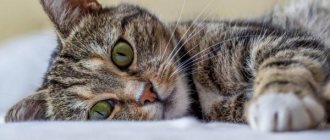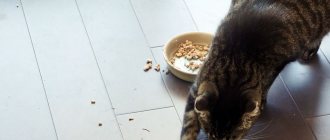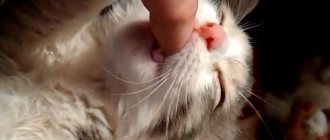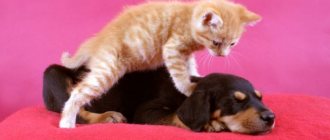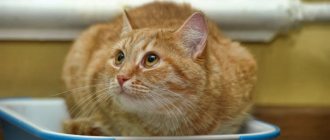A Brief History of Cat Domestication
By nature, cats are predators. These animals are freedom-loving and have a rather capricious character. A large number of scientists have been and are still studying the issue of domestication. It is assumed that the ancestor of today's domestic cats was the dun cat, which lived in the wild in North Africa. In appearance, it is most similar to modern pets. The Egyptians first started keeping it at home.
The structure of cats' paws
Initially, these animals actively spread throughout the territory of Ancient Egypt. This began during periods of agricultural development. After all, granaries of impressive size inevitably attracted the attention of rodents, which cats love to feast on.
For your information! In Egypt, cats were revered as sacred animals. The sun god has the form of a cat. Exporting animals outside the country was strictly prohibited; it was punishable by death.
These animals first appeared in Rus' in the 14th century. They were also loved and revered. The theft of a pet was subject to a fine commensurate with the fine for the theft of cattle.
The brown cat is the first domesticated pet
Surprisingly, in the Middle Ages in Europe, cats were considered involved in witchcraft, especially black animals. The final persecution ceased only in the mid-19th century.
Children's habit
You've probably noticed that when a cat massages a person, for some reason it purrs, squints and shows obvious pleasure. The fact is that the natural instincts inherent in cats remain with them throughout their lives.
In kittens, trampling with their paws is associated with receiving milk from the mother (lactation is enhanced by light pressure on the nipple area), and this, in addition to satiation, brings pleasure and joy of communication.
As pets grow older, their actions express trust in a person, associating him with his mother, in whose company he felt unusually calm and safe.
Why do cats trample their paws and purr?
Why a cat tramples its paws: the main reasons and what it means
A cat massages its paws - what does this mean? There is no exact interpretation, but scientists and simply cat lovers put forward several interesting versions. Each one undoubtedly deserves attention.
- Psychological release. It has been scientifically proven that cats are more stressed than humans. This condition can be provoked by many external factors: unusual surroundings and unfamiliar people, loud music or the appearance of another animal in the neighborhood. To relieve nervous tension, a massage cat awakens in the pet. He comes to his owner and begins to trample him with his paws.
- Behavioral instincts. The behavior of animals in the vast majority of cases is determined by instincts. The fact is that their ancestors hunted themselves and arranged a place to spend the night. So, in order not to sleep on a hard surface, the cats trampled the earth and grass with their paws. And even after hundreds of years, the instinct was not lost.
- Rhythmic movements of the front paws are also often called milk steps. Every person at least once in his life has seen how little kittens feed. This is how they tell their mother that they are full and satisfied. Animals retain these memories for their entire lives.
- Designation of territory. Scientists suggest that the cat massages people, blankets and other surfaces with its paws in order to clearly indicate its possessions. The fact is that animals have sweat glands on their paw pads. They release a secretion with a specific odor that a person cannot smell. But this does not prevent cats from understanding each other in this way.
- If a cat gives a massage, then this is a manifestation of pleasure and love. Many cat owners are convinced that paw massage is a manifestation of love and the highest degree of trust.
- Mating season. A cat or cat may begin to actively move its front paws with the beginning of the mating season. If there is no potential partner nearby, the animal switches to its owner and other household members it loves.
Cat massage
There is another widespread theory - an animal tramples its owner when it wants to improve his physical and psycho-emotional state. Sometimes people’s pain actually goes away due to the rush of blood to the place where the caring pet is trampling. There are several solutions to the problem - be patient and wait it out, find a friend for your pet, or have it spayed/neutered.
Note! Releasing claws and trampling are always, without exception, a manifestation of positive emotions, so you should not shout at your pet if she is scratched, you need to show your concern in return.
Children's habit
You've probably noticed that when a cat massages a person, for some reason it purrs, squints and shows obvious pleasure. The fact is that the natural instincts inherent in cats remain with them throughout their lives.
In kittens, trampling with their paws is associated with receiving milk from the mother (lactation is enhanced by light pressure on the nipple area), and this, in addition to satiation, brings pleasure and joy of communication.
As pets grow older, their actions express trust in a person, associating him with his mother, in whose company he felt unusually calm and safe.
What canned food tastes best for cats?
RESEARCH ATTENTION! You and your cat can take part in it! If you live in Moscow or the Moscow region and are ready to regularly observe how and how much your cat eats, and also remember to write it all down, you will receive FREE SET OF WET FOOD.
Project for 3–4 months. Organizer - Petkorm LLC.
Cats have many habits that seem strange to us. One of them is to give the owner a kind of massage, rubbing the skin with his paws and purring with pleasure. While figuring out why cats trample on people, ethologists have not come to a common opinion. However, there are several interesting theories that explain this touching ritual.
Most felinologists believe that a cat tramples with its front paws when it enters childhood. Watching the life of kittens, the owner can see how the babies crush their nipples with their claws - in this simple way they improve milk production. Being close to their mother, warm and safe, the suckling kittens rumble joyfully and stretch out their tails with pleasure - the height of bliss.
But why does an adult cat give a massage to a person? It turns out that this is mainly done by those pets who were separated from their mother early. Once in a new home, the kitten needs a mother and chooses an owner to take her role. Therefore, at the moment when an adult cat wants to relax, relieve stress, or simply enjoy the company of “mom,” she kneads the owner’s skin with her paws. However, this does not explain why the cat stomps on the blanket, because it is hardly possible to confuse the blanket with the mother’s belly.
A little about cat physiology and the reasons for this behavior
Why does a cat lick a person: the main reasons and what it means
Cat massage attracts a lot of interest among pet owners. From a physiological point of view, there is a rational explanation why a pet tramples its beloved owner with its paws.
So, as mentioned earlier, stomping is a way of marking territory. The paws contain a large number of ducts and sweat glands that produce and secrete a special secretion. In addition, the paws of all types of cats are sensitive due to the large number of receptors and nerve endings. It is inherent in nature that animals receive a large flow of information about the world around them in this way.
The results of numerous scientific studies have also shown that during diligent pawing and trampling, the pets’ body begins to actively produce endorphin - the hormone of happiness, which allows you to relieve stress, calm down and, of course, relax.
Ancient Egyptian painting featuring cats
Misconceptions
Sometimes “experts” in cat psychology explain their behavior by saying that by massaging something or someone, they receive psychological relief, and endorphins are produced in the body. But, excuse me, when a person experiences pleasure from food, affection or sex, doesn’t he release a hormone of joy? This version puts the cart before the horse and confuses effect and cause. The very act of moving one's paws is caused by pleasant feelings and joy, and not the other way around. With the same success it can be argued that Barsik purrs in order to become happy.
Don’t believe it when, when answering the question why cats knead us with their paws and purr, they tell you about therapeutic massage. Yes, the living warmth of an affectionate cat heals, relieves spasms, even nervous tension. Yes, she often chooses sore spots with elevated temperatures to snuggle and warm up. But Murkas do their “massage” not on the owner’s problem areas, but where it is convenient for them.
Observing cats at home, we notice that they, sensitively sensing and choosing warm places, are completely indifferent to the softness of the sleeping place. Therefore, the hypothesis that they trample the future rookery to make it softer can also not be considered.
Supernatural version: does the animal heal
How to understand that a cat loves you - signs of your pet's feelings
This is a common everyday theory, the reliability of which is not supported by anything. Pets are doctors, and their massage can be considered an effective therapy. As proof, cat owners cite the fact that their pets trample in the place where they experience severe pain.
In contrast to this version, it is worth remembering that in this way cats can “heal” inanimate objects that fall under their paws.
As you go to bed, so will you sleep
It is believed that the ancestors of domestic cats were several subspecies of the wild steppe cat, which, as the name implies, live in steppe, mountain and desert zones. At night, the ancestors of Domus hunt, and during the day they sleep, hidden in dense thickets of low bushes. It’s clear why cats stomp around when getting ready to sleep - they level a piece of land, crushing grass and branches to build themselves a comfortable den. Some zoologists believe that this instinct is still dormant in the genes of the domestic cat. If this is so, it becomes obvious why the cat stomps on the blanket - like a wild ancestor, it makes a comfortable bed for itself.
For many years, our family had a cat named Mister Miao, or simply Mimya. It was a large black cat with a white shirtfront and white paws. Mimechka’s most amazing habit was that if he saw one of the family members in a horizontal position, he would rush to the sofa, jump on the person lying down and begin his cat massage...
At first he carefully moved his paws and purred loudly, after 2-3 minutes he released his claws and the massage became dangerous. At the same time, the cat buried its nose in the clothes and sucked its tip. Rarely has anyone in my family endured such intense music therapy with self-harm for more than five minutes...
Mimya was amazingly musical. Depending on his mood, he could tenderly hum to himself, “rryau, rryauuu.” If he wanted to get something immediately, here and now, then our apartment was resounding with a loud “m-ya-ya-u-u-u,” and he pulled out the last sound for a long time and with anguish, knowing that this would knock out the owners in the second minute of it. concert.
As for the massage, I had to politely ask Mimyu to leave the victim’s favorite part of the body. Mr. Miao watched all the inhabitants of the house very carefully, hoping to see someone on the sofa or on the bed. The observant kitty taught everyone to be vigilant and not relax in the presence of the cat-masseur...
Why do some cats like to paw at some soft object? From the outside, this animal exercise looks like warming up its paws or “a cat kneading dough.” For their warm-ups, cats choose pillows, blankets, soft toys, another kitten, or the lap of their own owner - a favorite place for such exercises. It should be noted that not all cats have this feature. For example, my friends - big cat lovers - have three purrs in their house, and only one of them is actively involved in massage practice.
There are different theories to explain this unusual behavior of animals. Some believe that kittens massage their mother's tummy during infancy and thereby stimulate milk production. Those of them who were weaned too early retain the habit of kneading soft objects with their feet.
Another hypothesis regarding the massage behavior of cats explains it this way. Long ago, when cats were completely wild, before settling down for the night, they chose a secluded place to sleep, for example, tall grass or fallen leaves. To make the bed soft and cozy, they pressed it down until they thought it was soft and comfortable enough for them and their kittens.
There is also a physiological explanation for why cats “knead with their paws.” Cats have sweat glands on their paws. When they massage, they leave a specific aroma of these glands on an object or person. Such marked territory should warn fellow tribesmen that the place is occupied, stay away.
When a cat settles on the lap or other parts of the owner’s body, she shows her complete trust in him and communicates that she feels good and comfortable in the chosen place, and you are her personal property. Treasure your pet's trust!
Many owners of cats and cats are sure that a tailed doctor lives next to them, who senses when the owner needs his help. Treatment with cats is called felinotherapy. Pussy comes to the aid of the sick person: she warms the place where it hurts, massages the problem area with her paws, and purrs her simple song in his ear. After some time, the person feels better and forgets about his illnesses.
When a cat is especially happy, she tends to move her front paws in one place, consistently extending and retracting her claws. This movement is called the “milk step”.
This kind of affection can go to a person, other pets, as well as inanimate things, usually soft (for example, a cat can stomp on the bed for a long time and enthusiastically). Often, but not always, the baby step is accompanied by a purr.
There are a number of hypotheses to explain this behavior.
From this video you will learn several versions of why cats love to trample with their paws.
Recognition of the owner by mom
When little kittens massage your cat's belly, they increase the flow of milk to the nipples. At these moments, being next to their mother, they feel completely safe, they are warm, nourished and comfortable. Being already adults and feeling security and contentment, they can “fall into childhood” and knead their owner’s knees, like they once did with their mother’s belly.
This version is also supported by the fact that sometimes the “milk step” is accompanied by a quiet smacking of the lips. It has also been noted more than once that animals that are taken from their mother too early exhibit similar behavior more often, as if trying to compensate for what they lost in childhood.
Relieving emotional stress
Some breeders note that the pet may knead the bed or sofa too vigorously and angrily without purring. This often happens after the cat has been offended - they have not given a piece of sausage from the table, scolded, woken up, pushed from a warm place, etc.
In this case, stomping on furniture may mean that your pet is letting out stress. As a rule, such therapy helps and the cat quickly calms down. After this, she often returns to her owners, showing that she is no longer angry with them.
Preparation for sleep
By analyzing the behavior of wild cats, you can get another answer to the question why domestic cats knead the blanket with their paws.
In natural conditions, cats crush grass with their paws to make a bed for resting. According to a number of animal psychologists, this instinct remains with them to this day. Accordingly, before lying down on a blanket or on a person, cats first “trample” them down.
Massotherapy
Some believe that cats conduct a massage session for the sake of the owner himself, thus trying to cure him of some ailment or simply relieving accumulated muscle tension.
You can believe or not believe in the ability of cats to treat diseased organs with the help of energetic influences, but it is clear that massage is beneficial for the body in any case: it improves blood circulation, warms up muscles, promotes relaxation, and relieves stress.
According to some data, a cat’s purring itself has a healing effect: it promotes rapid cell regeneration and wound healing, and reduces the risk of a heart attack.
Owners who have several pets note that many dogs really love cat massage and even endure their claws extended for it.
Other reasons
According to some scientists, cats can crush people or furniture for a number of the following reasons:
- Marital advances. If an adult pet does not have a mate, it can transfer its unrealized sexual instinct to its owners. In this case, the animal will massage the person to express tenderness and receive reciprocal affection.
- Gratitude. Often, cats begin to purr and stomp on the owner’s body after stroking, as if trying to express their love and gratitude.
- Checking the resting place. There are numerous nerve receptors on the pads of a cat's paws that allow them to sense the world around them very subtly. By trampling on knees or a blanket, the animal tests their comfort.
- Production of happiness hormones. According to some studies, cats' purring and stomping stimulates the production of endorphins in their own body. Thus, the animal will purr and knead soft surfaces to improve mood and even correct poor health.
First, let’s ask how scientists explain this feature. They came to the conclusion that the habit of pawing is nothing more than a natural instinct. In infancy, when kittens are fed their mother's milk, they must apply slight pressure to the mother cat's mammary gland to ensure a smooth flow of milk. This habit persists especially long in cats that were separated from their mother early.
This explains why a cat tramples its owner with its paws. Probably, feeling the warmth of a human body, she remembers her mother’s warm tummy. Having settled comfortably on your lap, she begins to move her paws, demonstrating that she loves and trusts you almost like a mother.
In cats, eating is always associated with something very pleasant, therefore, a well-fed cat, which is in a state of peace and quiet, begins to make rhythmic movements with its pads that are familiar to us.
But then the next question arises: “Why does a cat trample the blanket with its paws?” Scientists also have an answer to this question.
A caring and experienced breeder will never allow himself to drive away a cat when she has decided to show her feelings. He will never show aggression towards his animal at this moment. The pet can perceive the owner’s reaction very painfully and harbor a grudge against him. Such a sharply negative attitude from a person will cause psychological trauma to the cat. This is completely understandable, because his mother never drove him away or showed aggression.
The pet may completely stop treating its owner kindly, and in some cases even begins to take revenge for his aggression. If the cat has released its claws, being too carried away during the “massage,” stroke its paw so that it hides them.
True cat lovers, who have one or more pets in their home, highly value any manifestation of attention and love on their part. The most independent and independent pets still show various signs of attention to their owners. Sometimes, at first glance, strange. For example, impatiens trample and move their paws on your stomach.
But why, and most importantly, why does a cat crush a person with its paws? There are several options to explain the reasons for these manipulations. From the mustachioed side it could be:
- expression of feelings;
- bed arrangement;
- relaxation.
When a cat tramples its paws, it releases endorphins. Methodical and unhurried movements have a calming effect on the animal, helping to relieve stress and calm down. Tactile receptors located on the paw pads help ensure that the chosen place to sleep is comfortable, safe and suitable for proper rest.
For kittens, such paw movements are one of the very first. As soon as they are born and reach their mother's nipple to feed, they begin to knead their mother's belly with their front paws. Thus, the main reason why a cat gets under the covers is its memories of its own childhood.
These movements stimulate milk to be produced better and more actively, which is very important for newborn kittens. At the same time, when a cat grows up and is separated from its mother, its instincts do not disappear anywhere. When wondering why cats knead the blanket with their paws, you should understand that at this moment they are happy, feel comfortable and safe. This awakens childish behavior, your pet feels as if he is again near his mother and crushes her with his paws.
But there are other reasons why a cat tramples a blanket.
Surely every cat owner who watches their pets notices something interesting or mysterious in their behavior. One of the most common questions that occupies the owners of these animals is why they often stomp their paws on a person, while emitting a loud purr? What does it mean? What is this connected with?
Why do cats trample on us with their paws and purr?
The main reason why cats knead their owners with their paws is an instinct inherent in them from birth.
During the feeding process, when kittens suck their mother's milk, they knead it with their paws, trying to improve its flow. At the same time, they experience a feeling of comfort, safety and security.
During the feeding process, when kittens suck their mother's milk, they knead her with their paws.
Very often, at such moments, cats lose control of themselves and use not only their paws, but also their claws. This is also connected with instinct, and you should not scold the animal if it is too carried away by “meditation”. If the cat owner feels pain and discomfort due to the fact that the pet has released its claws, it is enough to lightly stroke its paw so that it removes the claws back.
Massage and treatment
You may not believe in the healing properties of cats, but in fact, their close contact with the owner helps to improve the well-being of not only humans, but also the animal itself.
By stretching its paws on the owner's skin, the cat seems to be giving him a special massage. Many kitten owners have noticed that their pets stomp their paws not on any place on the body, but precisely where something is bothering the owner. Accompanying its actions with a loud purr, the animal promotes rapid cell regeneration in the human body and reduces pain.
Cats trample with their paws on the place of the body where something is bothering the owner.
Most often, fifteen to twenty minutes are enough for cats to undergo one session of such treatment. After this, they curl up on the owner’s lap or stomach and fall asleep, warming him with their warmth.
Desire to express love and gratitude
In an effort to express love to their pets, cat owners can use methods such as:
- stroking;
- combing;
- conversations with your pet;
- treating yourself to delicious food;
- games.
By stroking the owner can express his love to the cat.
A cat cannot express its love and trust in its owner through words or any actions.
That is why she tries to “caress” him in return, and the only way available for this is to trample with her paws on her knees. In this way, the animal establishes non-verbal contact with its owner, as if telling him: “I love you, I trust you, I feel good with you.” A loud purr at the same time indicates complete peace of the cat.
What does it mean when a cat tramples you with its paws?
How to stop a cat without offending it
When an animal willingly tramples on its owner and purrs, it gives the person painful sensations due to the extended claws. Cats can exert such force that they begin to pierce human skin, especially painful sensations in the abdomen and thighs. It is not recommended to scold an animal, since it shows care and affection, but there is no point in tolerating it.
Note! If you yell at a pet, it will leave, but still will not understand what caused such a reaction from the owner.
In order not to offend your pet and stop the process, you must do one of the following:
- abstraction. The owner simply needs to change the nature of the caresses. Due to a change in sensations, the beloved animal will stop releasing its claws for a certain period of time;
- putting the pet down. If your pet is trampling too actively, causing discomfort and pain, it is recommended to start stroking it more actively and gradually lay it on its side. This approach helps to quickly stop trampling with claws out without offending the pet;
- gentle stroking of the paws when the cat is trampling, forces it to hide its sharp claws and continue the massage without their participation. If you do this every time your pet gets carried away with the massage. After a short period of time, the cat will develop an addiction and will stop releasing its claws altogether.
Important! All veterinarians, psychologists and simply scientists unanimously repeat that it is impossible to scold a pet for trampling, since this manifestation is exclusively positive. A negative reaction can cause psychological trauma to the pet, and he will suffer from a lack of understanding of why he was punished, etc.
How to stroke a cat's paws so it doesn't scratch
Cat massage therapist
The mustachioed insolent lounging on the double bed. At the click of the camera, the “chiropper” lazily opened his right eye. He yawned and stretched, revealing his indecently thick belly. That’s how he met us - the unique Voronezh masseur cat Murzik. He goes to the right - the song starts... For the eighth year, this four-colored, eight-kilogram monster has lived with Alexander Mikhailovich Alekseev, recognized back in the 70s as the best massage therapist in the capital of the Black Earth Region. At the same time, eight years ago, Murzik’s owner was in a car accident and lost his sight after a retinal hemorrhage. But don’t give up your favorite activity. “Three years ago a patient came to me,” recalls Alexander Mikhailovich. - I am doing a massage. Suddenly the phone rings. I left the room, I was talking and suddenly I heard outside the door: “Okay. Press harder here. And at the spine. Great!" I come in: Murzik is walking around the client, and he is blissful. Since then the cat has become a chiropractor. Walks over a person, like on a golden chain in a fairy tale, for about ten minutes. Then he goes to rest. And sometimes he takes advantage of his official position and kisses pretty patients. Our Murzik is a womanizer... But Murzik doesn’t like cats. He is running away from marriage and does not want children. What for? After all, everyone adores him anyway. As soon as the owner turns away, they grab the cat in their arms and, well, pet it. And he purrs with pleasure. Murzik only charges for his treatment in sausages and tomatoes. He also loves melons, but no one has given them to him yet. And he himself is embarrassed to ask. The most common patients of the tailed massage therapist with “golden” paws are “new Russians.” It “relieves” neuroses and chondrosis in them. He treats the legs and lower backs of deputies and government officials, and owners of nightclubs and restaurants often ask Murzik to treat their stomach area. Usually the cat himself senses which part of the body needs his help. And it takes away the pain like a tail! Tailed blackmailer Your correspondent also decided to test the magical power of cat paws. They asked me to undress to the waist and lie down on the couch. The mustachioed aesculapian himself jumped onto the couch and walked along the spine. Then he pressed his paws between the shoulder blades, leaving claw marks, and perched on top: apparently, he decided to take a nap. And, most likely, he would have fallen asleep there if it weren’t for the flash. Alekseev attributed the sleepy appearance of the chiropractor cat to the hearty second breakfast of the green-eyed medical worker. Both lunch and afternoon tea. As we left, we learned about Murzik’s gluttony and another talent of his, hidden from his patients. He's a blackmailer. Whenever it wants to eat, the animal sits at the door, closed with a chain, and with all its appearance says: “If you don’t give me a melon, I will leave you. I'll run away. I'll make a career. Where are you going without me, the great massage therapist? What do we have on our plate? That’s the same!..” AND WHAT’S IT ABOUT THEM? Animals can cure any ailment! The effectiveness of animal therapy (treatment of diseases with the help of animals) is no longer in doubt among Western doctors. Cats and dogs are considered excellent “painkillers” - as soon as the animal lies down on the owner’s aching lower back, the disease recedes. But better than physical illnesses, animals heal mental illnesses. After the tragedy of September 11, specially trained dogs were included in the team of psychologists working with relatives of victims. They knew how to be kind and affectionate with strangers, and by communicating with them, many felt better. QUESTION - ANSWER Aquariums are washed with vinegar We bought a lightweight plastic aquarium. But the problem is that his front wall has become cloudy. How can it be cleaned? Elena. Ekaterinburg. If the wall is covered with algae, they can be cleaned off with a special scraper designed for plastic. You'll scratch it with a regular one. Or try the old-fashioned method: cover the aquarium with a blanket and leave it without light for a week - all the “green stuff” will die, but the higher plants will survive. Well, if the wall becomes cloudy after you rubbed it with detergents containing ammonia, then nothing can be done. Such aquariums must be washed the old fashioned way, with vinegar, since ammonia crystallizes the plastic. “Crusks” do not need vitamins. Should vitamins be added to ready-made dog food? Marina Bylinina. Moscow region. — If you feed your pet expensive, high-quality food, then no special additives are required. If you give additional bait, he may develop hypervitaminosis or even poisoning. However, additional vitamins will not hurt if the dog is pregnant or nursing puppies.



